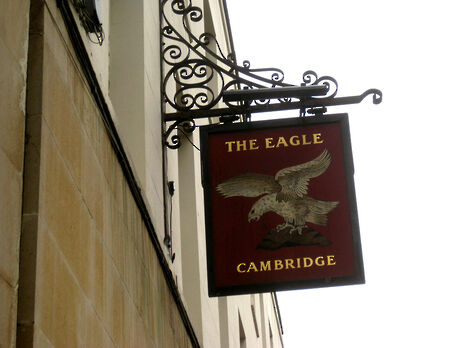New plaque unveiled to commemorate unsung heroine of DNA
Contribution of Rosalind Franklin is recognised at The Eagle pub, 60 years on

A plaque was unveiled in the Eagle pub last Thursday on the sixtieth anniversary of Francis Crick and James Watson’s announcement of their discovery of the structure of DNA. It commemorates the contribution of scientist Rosalind Franklin on their research.
The plaque was officially unveiled beneath another for Crick and Watson by Dame Carol Black, Principal of Newnham. Rosalind Franklin studied natural sciences, specialising in chemistry, at the women’s college and also taught there in the late 1940s.
Mr Stuart Laing, Master of Corpus Christi which owns the site where The Eagle is built, was also in attendance, having given the permission for the plaque’s installation.
This commemoration of Franklin’s contribution was the idea of Newnham Fellow and Senior Lecturer in the Department of Geography, Dr Emma Mawdsley, together with local resident Norman Sanders who is an alumnus of Trinity Hall. He organised the making of the plaque with two friends who are school design technology teachers.
Asked how she came up with the idea, Mawdsley said: “I was sitting in here with a beer one day looking at the plaque and thought, “What about Rosalind? Initially I thought I would do something cheeky like having a plaque made and stuck up on the wall with blu-tack and wait to see how long before anyone noticed”.
The choice of The Eagle pub, she said, was based on the establishment’s strong association with the discovery DNA structure (Crick and Watson’s declaration to bemused drinkers that they had discovered “the secret of life” is a local legend). It is a “nice site to remind people” of her contribution, Mawdsley noted at the plaque’s unveiling.
Rosalind Franklin’s impact on Crick and Watson’s discovery has long since gone unrecognised. The biophysicist had been working on the same project as Crick and Watson at King’s College London, and produced x-ray crystallography photos which clearly depicted the DNA molecule’s double-helix structure. Without her knowledge, a colleague Maurice Wilkins passed on one of these x-ray photographs – known as Photo 51 – to Watson, beating the King’s College, London group to the solution.
Franklin died from ovarian cancer five years later at just 37 before the significance of Crick and Watson’s discovery was realised. It is widely felt that that her contribution to their breakthrough was never properly credited.
The plaque joins a number of other recently instituted testaments to Franklin’s work in Cambridge including a post-graduate hall at Newnham College and a lecture theatre in the Genome Centre.
 News / SU reluctantly registers controversial women’s soc18 December 2025
News / SU reluctantly registers controversial women’s soc18 December 2025 Features / Should I stay or should I go? Cambridge students and alumni reflect on how their memories stay with them15 December 2025
Features / Should I stay or should I go? Cambridge students and alumni reflect on how their memories stay with them15 December 2025 News / Dons warn PM about Vet School closure16 December 2025
News / Dons warn PM about Vet School closure16 December 2025 News / Cambridge study finds students learn better with notes than AI13 December 2025
News / Cambridge study finds students learn better with notes than AI13 December 2025 News / Uni registers controversial new women’s society28 November 2025
News / Uni registers controversial new women’s society28 November 2025









